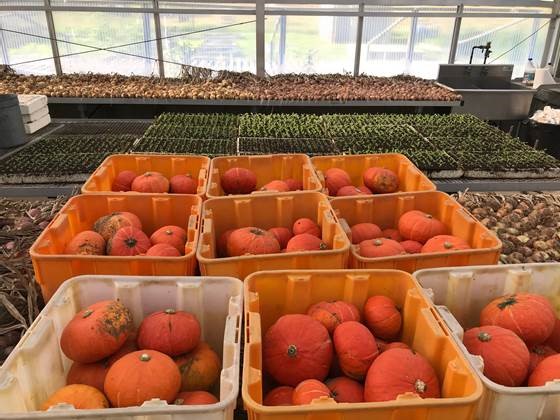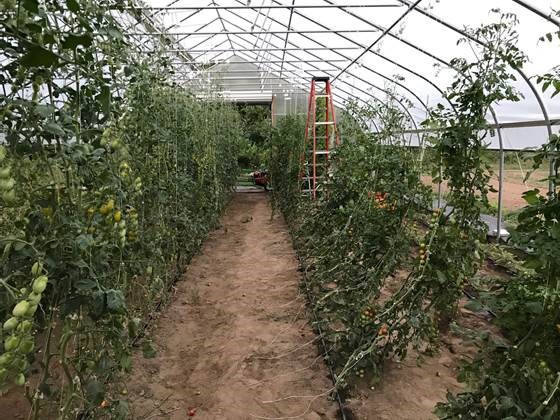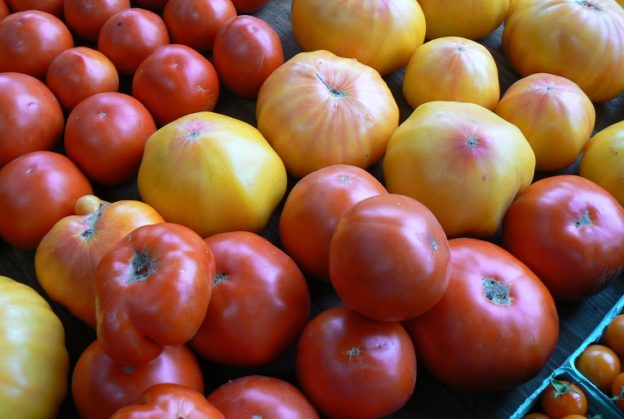The First Winter Squashes
It’s looking like fall in the greenhouse with the arrival of the season’s first winter squash: Sunshine orange kabocha. We harvested them last Thursday as soon as we saw the vines dying back leaving the fruit exposed. If we can detect orange in the field, so can the deer, and the deer love to bite into all types of winter squash, especially the orange kabocha and pumpkins. Those are storage onions you see drying on the benches around the crates of squash below, and those seedling trays behind them hold the second-to-last lettuce planting of 2020.

Lower & Lean
With transplanting nearly complete, we are spending most of our time weeding beds and harvesting melons, potatoes, peppers, and tomatoes. In the hoophouse, the cherry tomato vines are over twenty feet tall, so it’s time to “lower and lean” them. We get up on the ladder, clip the top growth to the twine, then let out three or four turns on the spool allowing the whole plant to sit down. Then we lean the plants to the side by jumping the spools to an adjacent zip tie or by sliding the tie along a truss. The lean provides easier access to the fruit and prevents a crimp from forming at the base of the vine. The red Sakuras on the right have been lowered and leaned, while the orange Golden Sweets on the left await their turn.

Why Are Our Crops So Flavorful?
Out in the field it’s hot and dry. You can check out your town’s drought status too–if looking at the powdery soil or your burnt lawn is not informative enough! Hurricane Isaias blew down some of our tall flowers and brought a little rain, but we’ll need more precipitation to ensure a bountiful fall harvest. In the meantime, we’re wearing our hats (check out Greg’s superb chapeau below) and enjoying the intensity of flavors in melons and tomatoes brought out by these extreme weather conditions. Jill’s theory is that our field cherry tomatoes taste better than those from the hoophouse because those in the field are not irrigated. If true, that would be the first on-farm example of something we’ve been saying for years: Drumlin produce tastes this good because it’s not watered- down. But the hoophouse cherries are also more fibrous than those from the field, which is strange considering that the fall and winter hoophouse greens were far more tender than their field counterparts.

Extreme Weather
Leaving aside the mystery of the watered hoophouse cherry tomatoes, we know for certain that we need more water on crops in the field! And some days not in the 90s would be much appreciated. This past Friday, we had to harvest the watermelon and cantaloupe first thing in the morning just to keep the fruit cool. We then stored them under tents (pictured above) to keep the sun off until we had a chance to wash and load them into the box truck and walk-in cooler. We’re doing our best not to overburden the under-sized reefer unit on the market truck, and if you let the sun hit the melons for any length of time, you wind up with dozens of molten crates radiating heat for the rest of the day.
Volunteers Needed
While it’s hot out there under the August sun, amazingly, volunteers continue to come and help us harvest in the fields and box CSA shares at the admissions area. But some of our regular community volunteers are beginning to quarantine themselves in preparation for college, so we’ll be needing more help through the fall. If you’ve been considering volunteering at the farm, now would be a perfect time. It’s a great way to get out, meet other masked people, and join in meaningful work that supports Mass Audubon’s conservation goals. In the past, at the end of August volunteer sessions, we’d gather round and cut into some watermelons and cantaloupe. Now we just send volunteers home with a melon to enjoy later. It’s different, but everyone who helps should know the sweetness they make possible.
Your Farmers


